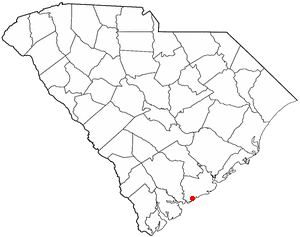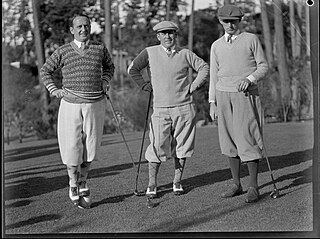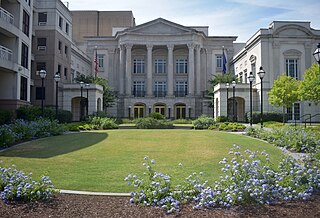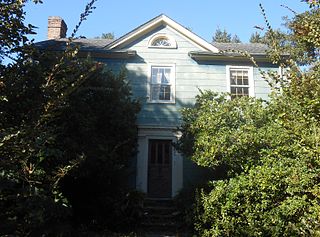
Kiawah is a sea island, or barrier island, on the Atlantic coast of the United States. Located 25 miles (40 km) southwest of Charleston in Charleston County, South Carolina, it is primarily a private beach and golf resort. It is home to the Kiawah Island Golf Resort, with spacious villas, beaches, large and acclaimed golf courses, and other attractions. As of the 2010 census, Kiawah Island's population was 1,626, up from 1,163 at the 2000 census. The island is part of the Charleston-North Charleston-Summerville metropolitan area. Alternative spellings and variants of the name itself include "Kiawa", "Kittiwar", and "Kittiwah". The proper pronunciation is sometimes considered difficult: the following reference provides an example pronunciation of Kiawah Island. Census Tract 21.04, located on the island, has a per capita income of $168,369, the highest in South Carolina.

Seabrook Island, formerly known as Simmons Island, is a barrier island in Charleston County, South Carolina, United States. The population was 1,714 at the 2010 census, up from 1,250 in 2000.

North Charleston is a city in Berkeley, Charleston, and Dorchester counties within the U.S. state of South Carolina. As of the 2020 census, North Charleston had a population of 114,852, making it the 3rd most populous city in the state, and the 248th most populous city in the United States. North Charleston is a principal city within the Charleston-North Charleston, SC Metropolitan Statistical Area, which had a population of 799,636 in 2020.

Robert Allan Cruickshank was a prominent professional golfer from Scotland. He competed in the PGA of America circuit in the 1920s and 1930s, the forerunner of the PGA Tour.

Shinnecock Hills Golf Club is a links-style golf club located in an unincorporated area of the Town of Southampton on Long Island, New York, situated between the Peconic Bay and the Atlantic Ocean.

Medinah Country Club is a private country club in Medinah, Illinois, with nearly 600 members and 640 acres (260 ha) containing three golf courses, Lake Kadijah, swimming facilities, a golf learning center, golf shop, gun club, racket center and a mosque-evoking Byzantine-style, Moroccan domed clubhouse topped with minarets and classic Moorish architectural aspects. Medinah is famously known for its Course 3, now at 7,657 yards (7,002 m), which has hosted five major championships: three U.S. Opens and two PGA Championships, as well as the Ryder Cup in 2012. Medinah will host the 2026 President’s Cup
Moor Park Golf Club is a country club located in Rickmansworth, Hertfordshire, England. It has two eighteen-hole golf courses, the High Course and the West Course, of which the High Course has hosted many professional and elite amateur tournaments, including the Women's British Open in 1985.

Henry Gilford Picard was an American professional golfer.

The Lambton Golf and Country Club is a private golf and tennis club in Toronto, Ontario, Canada. The golf club was established by Albert William Austin in 1902. The golf club is presently members with Golf Canada, and the United States Golf Association., and has hosted a number of competitions including the Canadian Open, and the Canadian Amateur Championship.

The Monterey Peninsula Country Club (MPCC) is a 36-hole golf club on the West Coast of the United States, located on the Monterey Peninsula in Pebble Beach, California.
Riverland Terrace is a historic neighborhood in Charleston, South Carolina. It was first developed starting in 1925. It is one of James Island, South Carolina's oldest neighborhoods. The Terrace is located 10 minutes west of downtown Charleston along Wappoo Creek and the inland waterway. The neighborhood boasts a public boat landing, Charleston Municipal Golf Course, a playground, five restaurants and numerous antique shops.
Rock Creek Park Golf Course is a golf course located in Washington, D.C., in the United States. The entire course lies within Rock Creek Park, a national park owned and maintained by the National Park Service division of the United States Department of the Interior.

Albert Wheeler Todd was an architect in Charleston, South Carolina. He is known for his neoclassical architecture, the design on his own home and of a home for Tristram Hyde. Todd was the senior partner at the firm of Todd & Benson which became Todd, Simons & Todd. Joseph F. Leitner worked with him. Todd also served in the legislature from 1910 until 1924 and was a State Senator.

Brackenridge Park Golf Course is a historic golf course in San Antonio, Texas and the oldest 18-hole public golf course in Texas. It opened for play in 1916 and was the first inductee into the Texas Golf Hall of Fame. Brackenridge Park was the original site of the Texas Open which held the tournament for most years between 1922-1959. Located in historic Brackenridge Park, the course is one of six municipal golf courses managed by the non-profit management group, the Alamo City Golf Trail. The Alamo City Golf Trail consists of Brackenridge Park Golf Course, Cedar Creek Golf Course, Mission del Lago Golf Course, Olmos Basin Golf Course, Northern Hills Golf Course, Riverside Golf Course, San Pedro Driving Range and Par 3, and Willow Springs Golf Course.

Brookland Plantation is a large plantation along Shingle Creek on Edisto Island, South Carolina.
Thomas Porcher Stoney was the fifty-third mayor of Charleston, South Carolina, serving between 1923 and 1931.

Lewisfield Plantation is a historic plantation house located near Moncks Corner, Berkeley County, South Carolina. It was built about 1774, and is a 2 1/2-half story clapboard dwelling. It is supported by a high brick foundation that encloses a raised basement. It has a five bay wide verandah supported by six slender Doric order columns. Records show over 100 slaves were held in bondage on the plantation as of 1835.
Seth Jagger Raynor was an American golf course architect and engineer. He designed approximately 85 golf courses in about 13 years, his first in 1914, at age 40. His mentor was Charles Blair Macdonald, the creator of the National Golf Links of America, and a member of the World Golf Hall of Fame.

The Gaillard Center is a concert hall and performance venue in Charleston, South Carolina. It opened in 2015 and replaced the Gaillard Municipal Auditorium. Both buildings were named after John Palmer Gaillard Jr., mayor of Charleston from 1959 to 1975.

Wagener Terrace in Charleston, South Carolina is a large neighborhood made property that had been owned by Louis Dunnemann and Capt. F.W. Wagener.

















